Welcome to a new Sitcom Tuesday and the start of our coverage on Murphy Brown (1988-1998, CBS). Unfortunately, only the first year has been released; look for it on Antenna soon.
An investigative journalist at a D.C. newsmagazine show faces all the trials and tribulations of being a career woman. Murphy Brown stars CANDICE BERGEN as Murphy Brown, FAITH FORD as Corky Sherwood, CHARLES KIMBROUGH as Jim Dial, ROBERT PASTORELLI as Eldin Bernecky, JOE REGALBUTO as Frank Fontana, GRANT SHAUD as Miles Silverberg, and PAT CORLEY as Phil.
The more shows about which I’ve studied and written on this blog, the more I’ve grown. For the past year or so, I’ve really made an effort to sharpen the seasonal commentary that precedes each Sitcom Tuesday list. Now when beginning a new series, I like to find a way to frame our coverage so that the ensuing analyses extend beyond the simple “there are more good episodes here than last year” angle. For Murphy Brown, I’m interested in looking at two things. Primarily, I’m interested in looking at why a ’90s sitcom that ran for ten seasons and was nominated every year (but its ninth) for Emmys (netting many big wins in the process) is not as popular as, say, Married… With Children (1987-1997, FOX) or Seinfeld (1989-1998, NBC), two contemporaneous shows with nearly commensurate longevities, but which can boast complete DVD releases, never halted exposure in syndication, and, today, generally larger and more vocal fan bases (perhaps the first two explain the latter, but it’s likely they’re interrelated). Conventional wisdom cites this show’s topicality, specifically its political topicality, as its primary hindrance, but while the nature of this discussion will preclude me from making definitive claims one way or the other, my aim is nevertheless to ensure that if you make this claim (that political topicality is the primary hindrance), you’ve done so with a thorough examination of the show’s construction, its trajectory, and its merits. (Decrying the show’s politics is the too easy answer. If it’s also the right one, then it has to be earned.) This brings me to the second thing I’m interested in exploring: its style. Or rather, the style of its creator, Diane English, who established the show’s tone and remained showrunner for Murphy Brown’s first four years before departing to Love & War (which I’ll be discussing in three March Wildcard entries – yes, I subjected myself to mediocrity in the hopes of aiding my commentary on English and her aesthetic; I’m actually glad I did).
While other long-running shows like Seinfeld and Married… With Children and, eventually, Frasier, all made stylistic impacts on the sitcom genre, English’s vision for Murphy Brown never seemed to exist beyond her own work. And yet, because Murphy Brown was likely among television’s better comedies for a few years, and quickly grew to became a sizable hit, it’s time someone looked at what she was doing. In fact, when thinking about the ways in which this series is unique, all figurative roads lead back to series creator Diane English, a novice whose previous credits included Foley Square (to be discussed — spoiler alert — in tomorrow’s Wildcard Wednesday post) and My Sister Sam (not to be discussed, simply because, while I have a near-complete set, Love & War drained me). This author’s personal goals and sensibilities so shape the series we’re here to discuss that it’s difficult not to claim that Diane English’s style is Murphy Brown‘s style. What is Murphy’s style? Well, it starts with the premise; English had always been admittedly drawn towards material that focused on strong career-driven women (and one of her trademarks is the unisex name given to her female leads: Alex, Sam, Murphy, Wally, Dana, etc.), so The Mary Tyler Moore Show was indeed a big influence on the way she viewed both half-hour comedies and the type of storytelling she wanted to resurrect. Rightly pointing out that there hadn’t been a great female-centric workplace sitcom since Moore’s series, filling this vacant space was precisely English’s intention in developing Murphy Brown, just as it had been, initially, in Foley Square. The delineations between Mary’s and Murphy’s shows would come not just from their natural existences within different eras, but also from the more ambitious and less restricted possibilities for female characters in 1988 (as opposed to 1970). Murphy Brown would be an evolved Mary Richards and Diane English would lead the evolution.
Contextualizing Murphy Brown as a Mary Richards for the ’90s surprisingly doesn’t do a disservice to the former. Sure — qualitatively speaking — The Mary Tyler Moore Show (1970-1977, CBS) represents a pinnacle of character-driven writing that’s very seldom, if ever, been matched in this medium, but the association between the two shows, and even the two characters, helps to succinctly explain both the foundation and even the appeal of Murphy Brown. During the time of the latter’s original run, comparisons were often made between the two, and it’s easy to understand why – the premise: single woman, career-driven, news business, group of associates, etc. In fact, the structure of the two shows is almost identical. Murphy is an older, more flawed, and advanced (career-wise) Mary. She has a history of competency in her job, but isn’t always likable, constantly struggling with personality issues and recently licked (established in the pilot) addiction problems. However, like Mary, she isn’t chasing a man. Murphy’s sidekick in the office, Frank, is Mary’s pal Murray: quick, dry, and at her side. Their stiff and idiosyncratic anchor man, Jim, is the show’s vain and goofy Ted, but with more brain cells, while Murphy’s boss, Miles, is an inverted Lou Grant — instead of a gruff elder, he’s a neurotic juvenile. The comparison becomes interesting here, for while Eldin, Murphy’s perennial house painter, is her at-home confidant, he’s not quite the Rhoda; neither is Corky, who as Murphy’s temperamental opposite, actually gets to serve as a more recognizable version of Mary Richards (a spunky newcomer in the newsroom), off of whom Murphy can be contrasted. So don’t be fooled into thinking that this mirrored structure is cause to label Murphy Brown shamelessly derivative. No, I actually think the similar design — especially with Murphy pitted alongside Corky — was absolutely intentional, meant to showcase that Murphy Brown isn’t a copy, but a matured variation. It’s a self-aware commentary on what television could do in 1988 that it couldn’t in 1970. For many, that’s the prime appeal, and from where English makes the series a distinct entity.

Where the show most finds its originality is in the subject matter. English wanted her heroine to not only represent the progress in how women were portrayed on television, but also in how women existed and were perceived in the workforce. Given that the show, like Moore’s, was largely set in a newsroom, English designed her series to actually engage directly in some of the dialogues of the time (something with which MTM — in contrast to the Lear shows — would only do indirectly, if it served character). The newsroom begged for discussion of current events and made time for lampoons, if not honest-to-goodness cameos, of popular figures of the day; and given the D.C. setting, politics was to be a fruitful source of story and laughs. This is where things get dicey. Murphy Brown’s obviously liberal slant (which came down, of course, from English) was always fodder for discussion by critics and viewers (and we’ll certainly be bringing it up in the weeks ahead), and alienated a portion of the audience right from the beginning. I won’t ever discuss politics here (I don’t think dissenting views should stop one from enjoying well-executed comedy), but we must discuss the show’s use of politics. In fact, some think the series no longer “holds up” today due, not just to general “datedness,” but specifically for its dated political bent… Now, I personally think every piece of entertainment is a product of the time in which it was made — a fact that shouldn’t be held against any work, but rather used as a means of understanding how we can find contemporary enjoyment — so, Murphy Brown‘s “dated” references, and its politics in general, only become an issue when, just like in all the Lear (or Susan Harris) shows we’ve discussed, they get in the way of character-driven comedy. Frankly, because the show’s identity was cultivated as such, D.C. politics had to be fodder for story. The problem arose when these politics became the series’ identity. (Stay tuned…)
This notion of political topicality – the factor that many believe has limited Murphy Brown’s post-run possibilities – is something we’ll need to explore more in the weeks ahead, when its detrimental impact on quality becomes so obvious that it’s no longer subjective. For while the show, because of English, always had a political foundation (one that may have indeed doomed it – from inception – to relevance only during the years in which it was first-run), there’s no denying that the series initially found success for reasons having little to do with the show’s use of subliminal politics. (English may have had social relevance on the brain, but at face value, this was just a new female-centric workplace sitcom.) Think about the sentiments expressed above regarding why the use of politics is troubling (and the politics themselves aren’t): it gets in the way of character-driven comedy. Murphy Brown’s politics are only problematic when they disrupt the very thing essential to the sitcom genre, which determines its quality. And if perceived quality is the primary reason we invest ourselves in certain shows, wouldn’t the perceived lack of quality be the reason we divest? In other words, isn’t it possible that Murphy Brown’s lack of a consistent quality control mechanism hits more to the guiding reason that Seinfeld and Married… With Children have, today, a great permanency in the hearts and minds of viewers? Hmm… it’s something to keep in mind during the weeks ahead, especially as ideas of quality are driven by English herself — certainly in these first few years, but really all throughout the run. In my evaluation of her own style, I’ve found that she inherently makes it difficult – for me, anyway – to love her work with the same enthusiasm as I do the aforementioned.
Let’s discuss. For starters, she’s still a novice at the time of Murphy Brown’s first season, so most of these observations are things that develop. Here, she’s flying by the seat of her pants – and for reasons discussed below – mostly succeeding (at this point). But in terms of English’s developing sense of humor, her writing tends to be very verbal and literate, placing emphasis on dialogue and the way patterns of speech define character. She’s also fascinated by romance’s place in the modern world, and as we’ll see in future Wildcard entries, she’s got a love of stylized old Hollywood comedies that isn’t often narratively invoked, but finds itself reflected in her optimism-in-spite-of-harshness motif. She’s smart and her scripts, for the most part, are as well, taking great pains to ensure that her players are regularly evolving, with their inner emotionalities the grounding reinforcement of their identities. To this end, she doesn’t mind drama, although comedy is still the preference. But because of her desire to not challenge the characters’ integrity with humor that could perhaps be unmotivated, her blend of emotional cerebralness is married, albeit estranged, to a mandate that the necessary big laughs must be achieved elsewhere — either in guest characters (like the revolving desk of secretaries) or specific comedically conceived stories. While The Mary Tyler Moore Show quickly dropped story-driven humor in order to build its characters (and the audience’s relationships with them) so the big laughs could eventually come from the regulars, English doesn’t have as much patience, opting to always stay connected to this occasionally forced “Victory in Premise” design – with the characters’ natural comedic capabilities bolstering, as in Moore’s series, with enhanced exposure, but only as much as the stories allow. (And because their foundations are as such, when the characters do go broad, it’s troubling.) This story-for-laughs relationship, even when the generally well-evolving characters can deliver the laughs, keeps the show from being as comedically powerful (and thereby memorable) as several of its aforementioned contemporaries.

There’s more that could be said about Diane English and her gleeful absorption of the self-importance heaped externally upon the series, and how her style came to embody lofty ideas more than the characters, comedy, or particulars of the given show on which she was working, but we’ll save that for another time, because actually, I have to note that none of the above is really a problem in Season One of Murphy Brown, for although — like most new shows — many of the early episodes are premise-based in an attempt to discover the characters before they can be used to guide the stories, the show’s generally solid MTM-inspired construction, along with both the freshness of English’s voice and her ability to reflect contemporary mores while showing the aforementioned progress both in the world and the medium, keeps us engaged enough to ignore foundational stylistic problems that, truly, can only be recognized in the broader context of the series’ evolution. However, what can be deduced here is that the newsroom is the most fertile place for story and comedy, and the characters – Phil and Eldin – who don’t have this as their natural setting end up not cultivating the necessary narrative bonds to the rest of the ensemble. Additionally, there are some characters whose comedy is clearer and better established – Murphy, Miles, and Corky – while the others take longer to find, specifically Jim, who is like Ted Baxter in needing a period of defrosting before he can become poised for solid laughs, and Frank, who I’ll admit right now to finding the least developed character of the entire series: functionally present to give Murphy a best friend, but a little too narratively malleable to be credited with a consistent depiction. I’m actually going to save most of my thoughts on Bergen’s performance as the title character for next week, following her first (of five) Emmy wins for this initial season of work. (Incidentally, English won an Emmy for her pilot script and Colleen Dewhurst won for her guest appearance – more below.)

In the meantime, I’d like to note that the first year (which was a mild hit – #36 for the season) actually starts the series off terrifically, and although I do think it takes several months for the show to find its groove, it discovers itself fairly quickly (compare this to Married… With Children’s several years) and enters into a routine of well-produced outings that will last for a while. It’s clear to see why the critics were taken with what they found in this first collection of episodes, and this list may be one of the most classic-filled of the series’ entire run. It’d be tempting, based on the volume of gems here, to even label it the best season – when the characters and series were fresh, culturally resonant, and not bogged down in comedy-suffocating politics — but I can’t quite go that far, for the following year will see the show becoming funnier and more-character driven as a result of its increased understanding of itself and its players, leading to an uptick in the base level of quality throughout even the mediocre renderings. (The second season of a series is often the positional beneficiary of a strong first year that found itself midway through – which is the case here.) So Season One, the only year presently released on DVD, can make due being my pick for Murphy Brown’s second best outing (although there will be another year or two that could provide some competition), and I, as usual, have picked ten episodes that I think exemplify this season’s strongest. For new fans, this list will give you a place to start. For seasoned fans, there might be a few surprises.
Here are my picks for the ten best episodes of Season One. (They are in AIRING ORDER.) Note that every episode this year is directed by Barnet Kellman.
01) Episode 1: “Respect” (Aired: 11/14/88)
Murphy returns from rehab to find a new executive producer.
Written by Diane English
As the pilot episode, this script has probably the hardest job of the entire series, for there’s a lot of expository details with which it must contend. In this case, it’s not so much the story — of Murphy interviewing a publicity monger who has instructed her new executive producer that he will not answer the single most pressing question (about his dealings with a vice presidential candidate) — as it is about the establishment of the characters, including our eponymous leading lady, those with whom she’s already familiar, and the new additions to the staff, Miles and Corky. English’s script does a solid job of laying out a premise for which — and a character for whom — stories should be plentiful. And although some of the dialogue itself, along with the performances, strike one as a bit stilted (as the players are still adjusting to her style), the generally well-crafted nature of the teleplay, along with several supreme moments that set up recurring gags — like the revolving door of secretaries and Murphy’s love for Aretha Franklin (and the music of the ’60s) — make this a winning pilot and a must-see seminal entry.
02) Episode 8: “And So She Goes” (Aired: 01/02/89)
Murphy is asked to give the eulogy for a colleague she hated.
Written by Denise Moss & Sy Dukane
There’ll be comparisons to The Mary Tyler Moore Show all throughout our coverage of Murphy Brown, but particularly in these first few seasons, as the “legacy” of Mary Richards is not just invoked subliminally through the depiction of Murphy’s character, but even through stories that one could pinpoint as similar. In fact, I tend to regard this episode, one of the show’s first comedic powerhouses, as one of several Murphy takes on “Chuckles Bites The Dust.” Finding humor in death — popular subject matter for sitcoms since the early ’70s — and the general irreverence for the deceased allows the show to play with Murphy’s own imperfections (which are certainly on a higher magnitude than Mary’s) and use them as a major source of laughs. Together, these elements weave delectably, creating a first season classic.
03) Episode 9: “I Would Have Danced All Night” (Aired: 01/09/89)
Murphy is beside herself when she isn’t invited to the president’s inaugural ball.
Written by Steven Peterman & Gary Dontzig
Although the show’s political inclinations turned off a significant percentage of the viewing audience (particularly as the show progressed and it used the messaging to supplant character-driven comedy), I think the incorporation of then-contemporary figures, along with a working relationship of then-current politics, helped to give the show appreciable flavor — not to mention, more fodder for story, which, in the early years, could be shaped throughout genuine character studies. With regard to this installment (written by the pair who’ll prove themselves to be among the show’s most consistent), it brilliantly uses the inauguration of the new president (Bush Sr.) as part of its story; even better: it’s consistently funny. A progression in identity.
04) Episode 14: “It’s How You Play The Game” (Aired: 02/27/89)
FYI tries to sensationalize its stories to compete in the ratings.
Written by Russ Woody
Jerry Gold will become an important player over the next several years, but this episode introduces the idea of his character without actually introducing us to him. The crux of the story has FYI attempting to compete with Gold’s smutty and sensationalistic show by incorporating such themes into their own work (simply as a way to get viewers to tune into the harder-hitting fare they feel deserves to be seen). It’s a terrific premise — as most of the show’s news-based ideas are (that’s something that this series certainly has in common with Moore’s show) — and the idea alone is probably what elevates its standing today. Otherwise, the comedy here is broader than previously seen and, because this is not English’s style, it’s occasionally forced.
05) Episode 15: “Mama Said” (Aired: 03/06/89)
Murphy gets a visit from her emotionally estranged mother.
Written by Diane English
Colleen Dewhurst, who won an Emmy for her work in this episode, makes her first appearance as Murphy’s mother, Avery Brown. Without a doubt, Avery is the strongest recurring presence on the series and Dewhurst’s untimely death at the start of the fourth season is a significant loss to the show and its potential. A figure with an utterly unique sense of comedy and an unmatched emotional complexity (supplied by both her nuanced performance and the fraught relationship between these two characters), every episode in which she appears is a winner. I go back and forth as to preferring this installment over her two-part appearance next season, but this episode’s intense focus on Murphy’s character, her past, and the specific relationship she shares with her mom, begets drama that is earned and supported by laughs. A classic.
06) Episode 16: “Moscow On The Potomac” (Aired: 03/13/89)
Murphy meets her match in a visiting Soviet newswoman.
Written by Sy Dukane & Denise Moss
This script was written by Dukane and Moss (Roseanne, Frasier), who contribute some of the funnier, but more broadly conceived entries from the first few years. While their “batting average” won’t remain so consistent in the years ahead when the show’s own aesthetic can’t quite handle tonally comedic (and sometimes story-heavy) outliers, all three of their efforts from Season One made this list. “Moscow On The Potomac” is the most popular and well-liked of the trio, but I must admit to struggling with it; despite the funny idea, the exaggerated depiction and portrayal of Murphy Brown’s Soviet equivalent (Robin Strasser) is grating. However, because the funny idea does well with Murphy, I like it more than I don’t.
07) Episode 18: “Funnies Girl” (Aired: 04/10/89)
Murphy and the staff become fodder for a local cartoonist.
Written by Tom Seeley & Norm Gunzenhauser
As with several other episodes on today’s list, this is one of those installments that I like to call a “Victory in Premise,” because the primary reason that we derive enjoyment from this outing is due specifically to its premise and the comedic idea upon which the script (like most by this particular duo) is founded. Frankly, I don’t think the episode does anything particularly masterful with regard to the depiction of the characters or the implementation of its comedy, but the use of these characters (again, Murphy) within an idea that’s inherently humorous allows it to stick out among this first season crowd — which is a feat in itself, considering that this year, although probably not the absolute strongest, is certainly treasure-filled.
08) Episode 19: “The Unshrinkable Murphy Brown” (Aired: 05/01/89)
Murphy loses her edge when a judge she’s interrogating dies on live TV.
Written by Denise Moss & Sy Dukane
While “And So She Goes” used death as a theme from which to mine irreverent humor and further define its leading lady, this installment uses death as a more legitimate plot point to explore its leading lady in a manner that’s knowingly more serious. You see, the idea itself, of Murphy laying into a politician who dies on national television, is amusing, but the introspective place that Murphy goes as a result of the situation doesn’t naturally engender laughs. Yet the episode smartly works in both a comedic and dramatic centerpiece, as Murphy attends a group therapy session — it goes about as well as you might expect — that helps to deliver the necessary hilarity while resolving the weekly dramatic conflict. Expertly well-rendered!
09) Episode 21: “The Bickners” (Aired: 05/15/89)
Murphy gets sued by a sweet elderly couple after a minor traffic accident.
Written by Russ Woody
Another idea that works because it’s humorous on the page, I find that this installment nevertheless supplies most of its comedy from the execution — within the script itself, the casting of the Bickners (played by two familiar faces, Eric Christmas and Amzie Strickland), and the way the story can play with making Murphy look like an imperfect individual. There are a few particularly amusing bits here, such as the whole runner about the accident having disturbed the Bickners’ sex life, and the return of Murphy’s second secretary, Robert, who actually proves himself to be of value before deserting Murphy to take a job in comedy development. (Gotta love when the show mocks the TV industry — classic late ’80s self-reflectivity.) Funny.
10) Episode 22: “The Morning Show” (Aired: 05/22/89)
Murphy and Corky co-anchor the network’s morning show.
Written by Kathryn Baker
My choice for the best episode of the first season, I must admit that this wasn’t necessarily an easy choice, primarily because I consider this year to be in possession of many episodes that are distinguished and worthy of being singularly highlighted on their own individual merits (like “Mama Said,” the other real contender). Ultimately, I tend to view this installment as the year’s most seminal because, frankly, it boasts the most humor, much of which comes from Murphy entering a scenario that logically uses the television news premise as part of its construct, and naturally yields humor that is based around characters and their relationship (specifically Corky and Murphy, who are tapped to co-anchor the morning show). By this point in the run, we know the characters pretty well, and this entry just seems to cement this understanding. It embodies the best of where the first season has taken Murphy and looks forward to an even better year ahead. One of my favorites of the entire series; just a perfect Murphy Brown.
Other episodes that merit mention here include: “Why Do Fools Fall In Love?,” the closest to making the above list due to its tight narrative that most makes the case for why Frank and Murphy have a relationship as important as the series has been trying to make us believe, along with “Devil With The Blue Dress On” and “Nowhere To Run,” the second and third episodes, which establish Murphy’s relationships with Corky and Miles, respectively. Of more honorable mention variety are “Kyle,” notable for its guest work by Leslie Jordan, “Soul Man,” a quintessential Murphy Brown story that needs more laughs, and “Summer Of ’77,” which purports to be character revealing but seems more enamored of its narrative.
*** The MVE Award for the Best Episode from Season One of Murphy Brown goes to…..
“The Morning Show”
Come back next Tuesday for the best from the second season! And tune in tomorrow for a new Wildcard Wednesday!


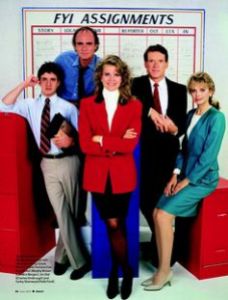

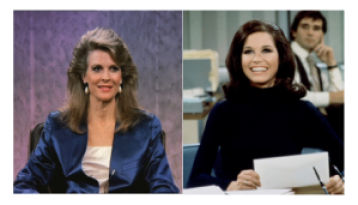



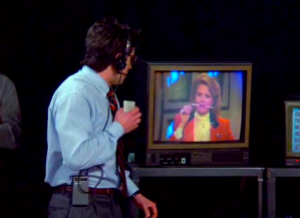
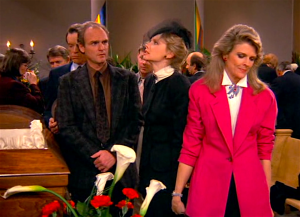
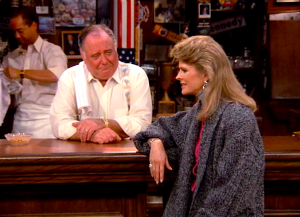

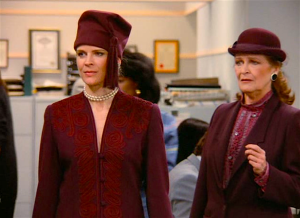




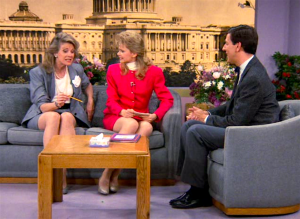

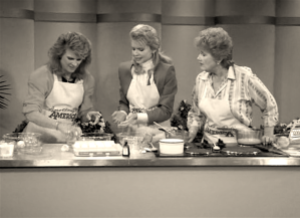
My understanding is that music clearance issues will prevent any more of Murphy Brown from being released, due to the use of a Motown tune in the opening to every episode. It’s a real shame. This was one of my favorite shows at the time it aired, and while I don’t think it’s held up all that well overall through the years, there’s still a lot that does, and for those of us who lived through these years, even the episodes that might now work for new viewers today can still be a kick.
One of the things that grates on me now, which didn’t at all back when this was a new show, is how much of the show depended on rote formulas, despite it having a legitimate claim to breaking new ground in many ways. There were lots of formulaic running jokes (e.g., the bumper sticker on Murphy’s dart board; the incompetent/crazy secretaries), some repeated basically every single week, and certainly a lot of formulaic jokes that were little more than references to figures in pop culture with no real wit behind the reference.
Several of the characters, too, feel a lot more over-the-top and two dimensional to me now than they did back in the day, notably Miles and Jim. Miles’s hysteria, e.g., can be funny, but it’s a note that I think they played FAR too often and too broadly when I rewatch the show now. Frank and Murphy were much more well rounded characters, their friendship one of the strongest and most interesting relationships on the show.
Their real ace in the hole, though, beyond how good Candice Bergen and the Murphy character were, was Corky/Faith Ford. She was the MVP, as far as I’m concerned, and the way they grew her character beyond the ditz she was initially is a fascinating case of adding real depth to a sitcom character without neutering what made the character funny to begin with (as with, e.g., Archie Bunker).
I look forward to reading your coverage of the later seasons– excellent piece, as always, Jackson!
Hi, WGaryW! Thanks for reading and commenting.
You’re right — dimensionality will prove to be an issue for most characters on this series, because English had insurmountable problems with humor. She limited the character-driven sources from which big laughs could be culled. The unappealing broadness (which you aptly addressed) that eventually came to plague the better and more comedically designed characters, particularly Miles and even Corky (whose laudable growth was not impervious to these major foundational problems), is a function of other players, including Murphy herself to some capacity, not being as reliable when it came to humor.
As discussed in this entry, I am not as fond as you are of Frank or his relationship with Murphy, as I don’t think English did a strong enough job of fleshing out his character independently from the heroine for whom he was designed to support. However, as with the MTM shows, all the relationships, especially this one, did indeed strengthen as a natural result of time (alongside the show’s noble attempts to narrow down for Frank a set personality). Ultimately, I always find him, in any era, more narratively functional than emotionally (and thus comedically) believable — the weakest of the original newsroom crew — but there will certainly be episodes ahead in which he asserts his value (especially when the familiarity of their bond proves to be the only thing of actual merit); stay tuned…
Looking forward to it! :)
I haven’t seen MURPHY BROWN in years but lost interest after Season Three for reasons you and Gary (above) have laid out or hinted at. I’m eager to see what you have to say about the next few years.
The first season was strong, but hardly anyone (that I knew) was watching. CBS’ Monday-night lineup was not as solid as it had been or would be with neither NEWHART (in decline) nor DESIGNING WOMEN (ascending) at its peak of popularity. I was surprised, though, after I discovered MURPHY, that it had not garnered more pre-season love from the critics. If memory serves, TV GUIDE in its Fall ’88 preview touted three other sitcoms — ROSEANNE, EMPTY NEST, and DEAR JOHN — but gave MURPHY little mention. Perhaps it was the show’s lack of pedigree or a crowded field of entrants that kept it off the radar?
Hi, Red Herring! Thanks for reading and commenting.
I think those are good guesses — Diane English’s track record would have given no indication of this series being a winning property. Stay tuned for more MURPHY BROWN (and English) over the next nine weeks!
I was also surprised to read in the post that “Murphy Brown” only finished at 35th place for the first season. I remembered it being a much bigger immediate hit than it must have been!
You must have been paying more attention to the critics than the Nielsens! The series didn’t crack the seasonal top ten until its third year, following two rounds of support from the Television Academy. Stay tuned…
It wasn’t until after the Emmy nominations in ’89 that I recall widespread buzz around the show. Like HILL STREET BLUES and CHEERS before it, MURPHY BROWN benefited from the Academy’s recognition. It was a dark horse until then.
Indeed, and ’twas easier to contain the series’ self-importance before it had the numbers to fuel its ego. Stay tuned…
Although admittedly never a fan of MURPHY BROWN and far from an expert on the series, I nonetheless am interested in your take as we go along on how a show that ran for a decade could virtually disappear without a trace soon after.
What I am a little surprised at, and maybe you will bring it up in future weeks, is that, while referencing the obvious ancestral link to THE MARY TYLER MOORE SHOW, wouldn’t another very clear forerunner to MURPHY BROWN have been MAUDE? MAUDE was a stridently political show about a stridently liberal woman, as was MURPHY BROWN, and MAUDE was also summarily rejected in syndication and, quite like MURPHY BROWN, vanished with nary a trace within a decade of its last airing.
MAUDE was not a workplace sitcom, but in many ways it seems that it served as just as much of an influence on MURPHY BROWN as the MTM SHOW did.
Hi, Guy! Thanks for reading and commenting.
Comparisons between the two shows have been made before in the comments of these posts (mostly by other readers) and MAUDE will indeed be mentioned in upcoming weeks when MURPHY BROWN becomes as political as MAUDE was in its beginning; stay tuned…
In the meantime, I can tell you that I think there are neither structural nor comedic links between the two shows as implanted by English (specifically because her work could never be as laugh-out-loud funny as a well-functioning Lear series) and the only reason an association exists is because both shows’ perceived political topicality has led to charges of “datedness,” which is then used as the primary excuse for why syndication was scant. I think, in both cases, it’s not the wrong answer — perception is reality — but there are debatable degrees of truth in accepting “datedness” as the fatal flaw, for I think both shows must also account for foundational writing problems that made their “political topicality” a more convenient excuse for why they were less worth revisiting than a more topical, but better written show, like ALL IN THE FAMILY.
Additionally — and there will definitely be more on this front in about a month — the two shows inherently used their politics differently when they began, and then their relationships to this part of their identities developed contrastingly; MAUDE pivoted away from the political and became a better series, while MURPHY BROWN leaned in to the political and became a worse one. This is something we’ll be discussing soon. Stay tuned…
Agreed, mid-70s era MAUDE could be, at its best, pretty damn funny. I think what overrode ALL IN THE FAMILY’s topicality and prevented the show from falling prey to being dated was that Archie and Edith (more than Mike and Gloria) were wonderfully compelling characters impeccably portrayed who forged an indelible connection with the audience in a way that no characters on MAUDE ever could. That and great writing. AITF could be riotously funny in episodes that were not topical at all.
Indeed, the answers almost always reside in the construction of the characters; stay tuned…
Don’t you think the Maude comparison comes from the similarities in the personalities of the main characters?
On another note, I don’t think English did herself any favors through casting. In fact, outside of Bergen, I would include Murphy Brown in her portfolio of poorly cast shows.
Hi, Scott! Thanks for reading and commenting.
As previously mentioned, MAUDE will be addressed in future posts (in a fairly significant way), so please stay tuned! We’ll have a lot to discuss.
Regarding your question, I think, yes, viewers drew comparisons between the two characters because they were both outspoken and occasionally gruff liberal females couched in varyingly political shows. Their reputed capacities for audience alienation (the current and most common framework for their conceptual pairing), however, is politically founded (I don’t think there would be reason to make comparisons if the shows weren’t political in nature), and is said to be the reason for both shows’ poor syndication performance. It’s a common big picture view and it’s completely logical; I won’t refute it.
However, I don’t think MURPHY BROWN had an “ancestral link” to MAUDE because I don’t think the former began with intentions to invoke MAUDE (or any Lear series), and it doesn’t inherently reinforce similarities – comedically, structurally, even temperamentally – beyond the surface characteristics of the two leads. So I think linking the shows – especially from the jump – is so prescient that it’s nearly false, because the only aesthetic they textually shared from inception (that is, the thing mutually found within their own individual constructs) is uneven ensembles around a too-powerul lead (to which, as you opined, the casting is a significant contributor).
That noted, there will come good reason to rope MAUDE into a discussion about MURPHY BROWN in several weeks with regard to their different political trajectories and for the latter’s adoption of an identity that is indeed more comparable (both a result and justification of these previously half-earned connections), which will then ultimately help progress two narratives we’re following: English’s stylistic development and the show’s overarching reputation-damaging textual deficiencies. Stay close…
CBS hit a brick wall launching sitcoms in the 80’s – and outside of Mondays. This is only the fourth one that stuck after NEWHART (’82), KATE & ALLIE (’84) and DESIGNING WOMEN (’86).
Hi, Jake! Thanks for reading and commenting.
Stay tuned for my thoughts on NEWHART, coming up later this year!
I can’t wait to read more about this show I loved as well, particularly the one when the crew is on strike (I just laughed and laughed and laughed, I still have it on a VHS tape I’m trying to dupe!) and when Miles was being interviews (I still sometimes mock and say “I’m walking, I’m walking, What?” which is what he said when he wanted to get a good photo pose).
Hi, bobster427! Thanks for reading and commenting.
Stay tuned for my thoughts on MURPHY BROWN’s second season next week!
Since we are done with the eighties after the seinfeld pilot. What has been your favorite seasons of the decade
Hi, Track/Nicole! Thanks for reading and commenting.
I don’t typically like to do this, but I know you’ve been wanting to know for a while! Now… this only takes into consideration material that’s been covered so far on this blog. I may change my mind after examining NEWHART later this year, but I suspect these will all hold.
1980-81: TAXI (S3)
1981-82: THREE’S COMPANY (S6)
1982-83: CHEERS (S1)
1983-84: CHEERS (S2)
1984-85: THE COSBY SHOW (S1)
1985-86: THE GOLDEN GIRLS (S1)
1986-87: THE GOLDEN GIRLS (S2)
1987-88: IT’S GARRY SHANDLING’S SHOW (S2)
1988-89: CHEERS (S7)
1989-90: MARRIED… WITH CHILDREN (S4) (for laughs) /
MURPHY BROWN (S2) (for episodic success rate)
And although we’ve still got several more 1990-91 seasons to examine, it’d be no surprise that CHEERS (S9) would take the honor of being my favorite from what’s been and will be discussed.
i figured season nine of Cheers would be your favorite. That season is growing on me as well
Finally catching up on your thorough and thoughtful coverage of MURPHY BROWN. I adored this show for much of its first run and have managed to catch it in syndication a few times. I find its reputation as being topical is warranted-especially in later seasons- but I don’t find it dated, at least not as far as the humor is concerned.
I do think that it’s politics hurt it though and helped bring about its descent ; Several later years are nigh unwatchable — which is why I think I agree with the thought that the series lack of consistency and its reduced quality over a long period of time is the kicker. Am going to read the next two now – great work!
Hi, Elaine! Thanks for reading and commenting.
I appreciate your kind words. Stay tuned for much more on the series’ politics and quality in the years ahead!
I finally got to watch this season. I enjoyed this list, but am curious as to why you didn’t mention My Dinner With Einstein here. That being said, I look forward to seeing the series on Antenna soon. Thanks for inspiring me to check this show out!
Hi, Charlie! Thanks for reading and commenting.
I find “My Dinner With Einstein” broader than the season’s norm and not as strong for the regulars, placing too much of its worth in Buck Henry’s appearance.